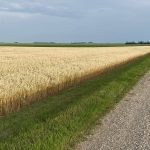
South Sask. ranchers win environmental award
Mark and Karin Elford ranch at Killdeer, just north of the Montana border, in a vast expanse of grasslands at a high elevation

Mark and Karin Elford ranch at Killdeer, just north of the Montana border, in a vast expanse of grasslands at a high elevation

Southern Saskatchewan ranchers said signing the agreement allows them to continue raising cattle and be rewarded for providing habitat

One tonne of oats produced in Saskatchewan has a carbon footprint 201 per cent lower than that produced across the country

One tonne of oats produced in Saskatchewan has a carbon footprint 201 per cent lower than that produced across the country



Landowners who want help controlling Richardson’s ground squirrels should contact the Saskatchewan Wildlife Federation


Potential changes to provincial regulations would create a licence category should agricultural products be approved for drone spraying

The beef industry has become more efficient and is finishing larger cattle to make up for the lack of numbers